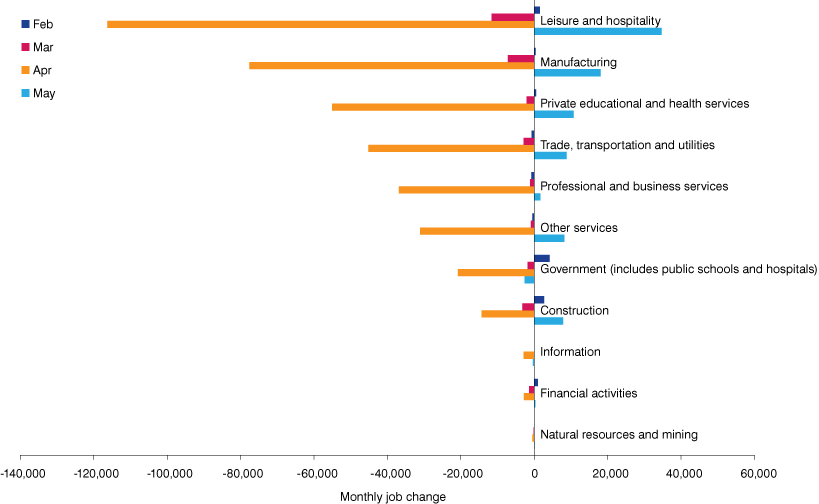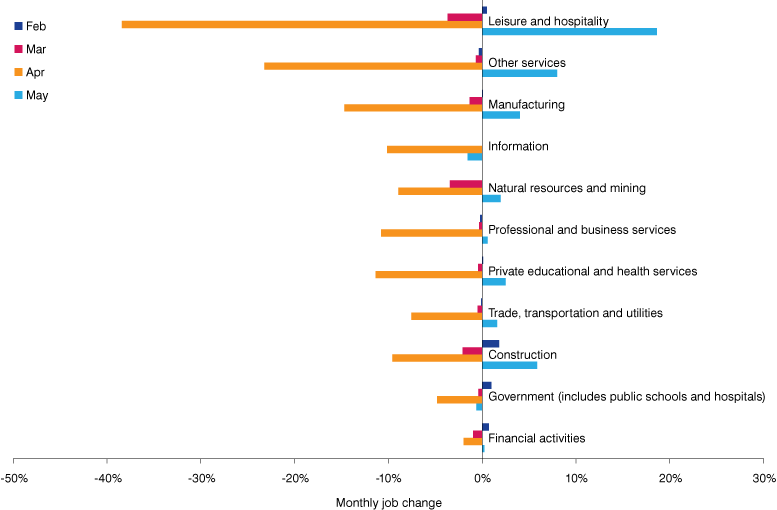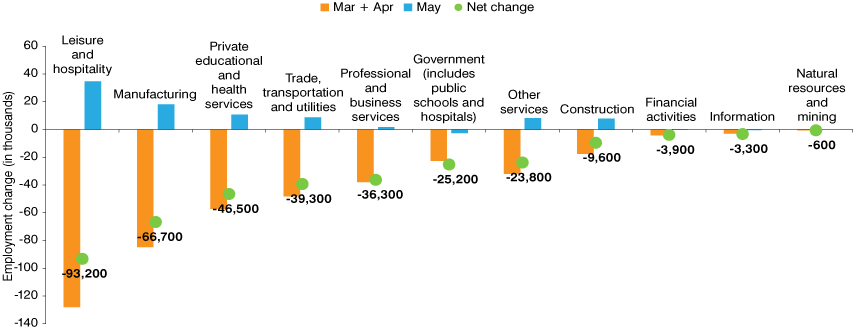The unequal employment effects of COVID-19

The longer term impact of the crisis on the leisure and hospitality sector is not known and likely will remain unknown long into the future.
The inequalities of those afflicted with COVID-19 are compounded by the job effects of virus mitigation attempts. In an attempt to social distance, businesses beginning in March either closed or dramatically altered their operations. This resulted in a sudden and profound reduction in employment starting in March 2020.
The workforce has always been subjected to divisions, but even more so during mitigation attempts given that there are two categories of jobs: those that are conducive to remote work and those that are not. Thus, changes in employment varied by occupation based on the ability to conduct the function of the occupation remotely. For example, an office position has the potential to be completed remotely, whereas a hairdresser cannot. Therefore, the impact of virus mitigation strategies in the labor market was asymmetric. While all sectors of employment were negatively impacted, some sectors were hurt more significantly.
Using U.S. Bureau of Labor Statistics (BLS) Current Employment Statistics (CES) estimates, the employment changes for 2020 can be aggregated by supersector (i.e., natural resources and mining; construction; manufacturing; trade, transportation and utilities; information; financial activities; professional and business services; private education and health services; leisure and hospitality; other services; and government). Figure 1 displays the monthly change in employment for each category starting in February 2020.
Figure 1: Monthly employment changes by supersector

Source: Seasonally adjusted CES data from the U.S. Bureau of Labor Statistics
Figure 2 shows the monthly change in percentage terms for each supersector. In all job categories, decreases were observed in March (except for information, which showed no change). The losses in April were significantly worse. A large segment of those Indiana jobs returned in May, but several more impressive months of job growth will be required to return to pre-COVID-19 levels.
Figure 2: Monthly percent change in employment by supersector

Note: Sorted by total percent change in employment since March.
Source: Seasonally adjusted CES data from the U.S. Bureau of Labor Statistics
If the job losses of March and April are combined and compared with the gains in May, the net change of those three months indicate the difficult challenge ahead in restoring the Indiana labor market. While it is hoped that future months will help the employment picture as businesses continue to open, this is dependent on an unknown virus and health concerns. It is also dependent on an unknown amount of structural erosion in the economy. The virus and/or structural erosion in the economy may cause labor changes well into the future and not yet seen.
Figure 3: Net change in Indiana employment

Source: Seasonally adjusted CES data from the U.S. Bureau of Labor Statistics
While there is considerable debate on the potential speed of the recovery and permanent damage, one can examine the data to observe who carried the initial weight of the crisis. The categories most affected by the crisis are manufacturing and leisure and hospitality. Manufacturing fell as shops closed. How quickly they can return will be a function of the virus and the ability of those shops to implement social distancing guidelines.
Employment in the leisure and hospitality sector was devastated by the virus. Additionally, this sector may have the most difficulty adhering to new social distancing guidelines. The viability of restaurants/bars with seating restriction is unknown. The longer term impact of the crisis on this sector is not known and likely will remain unknown long into the future.
Trade, transportation and utilities saw a marked decline, but also endured a reallocation of employment. Retail trade saw considerable disruption. Clothing stores and nonessentials were closed and jobs were lost, but essential retail like groceries witnessed increasing employment. Likewise, distribution jobs undoubtedly increased and online ordering spiked during lockdowns. This job category witnessed and will continue to witness considerable job turnover.
Construction, information and financial activities were the least affected of the major categories of employment. These categories were sometimes deemed essential and done outside. In the case of information and financial activities, these jobs are primarily office based and in many cases were switched to remote work. Thus, these categories were less impacted by the mitigation strategies and witnessed a less severe drop in March and April and, on net, have carried less of the economic burden.
In examining the uneven impact of virus mitigation strategies on employment by sectors, it can be observed that the sectors most impacted are those that offer the lowest wages. The employment burden is likely being carried by those least able to afford the weight or have sufficient savings to weather the crisis.
